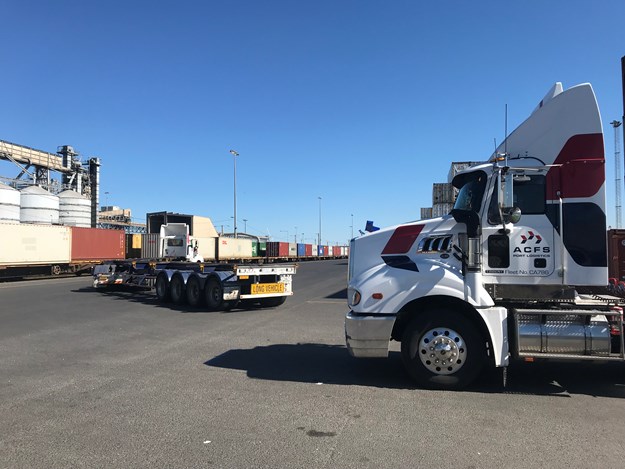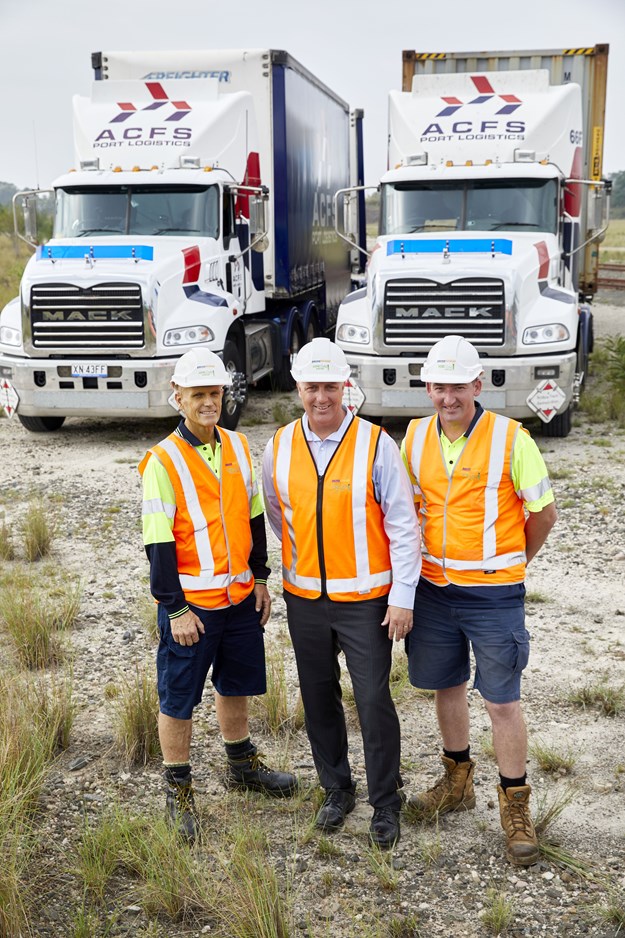Approval for the St Marys Freight Hub means that ACFS Port Logistics and Pacific National will have a highly strategic base for operations in NSW
It is sometimes said the transport and logistics landscape we know now will be unrecognisable in five years’ time.
Five years ago, a company named Asciano – born in 2007 when the vaulting vertical-integration ambitions of Toll’s former leaders hit the wall of competition regulation – strode the Australian stage like a behemoth.
And when it was eventually broken up in 2016 by investment consortiums, rail firm Pacific National (PN) and what would become ACFS Port Logistics were left as standalone operations, albeit with a relationship already spanning quite a few years.
“It was post that transaction that ACFS and PN started discussions,” ACFS CEO Arthur Tzaneros told ATN after the NSW government go-ahead for the St Marys Freight Hub last month.
“There are obviously some strategic alignments, with ACFS being the biggest container logistics provider and Pacific National being the largest rail operator.
“And for us to be able to provide and end-to-end solution around metropolitan rail services, it was only logical strategically that we were discussing opportunities and St Marys was at the top of that.”
THE ZONE
Construction approval for the St Marys Freight Hub is big news for PN but it is in a different order of magnitude for managing and operating partner ACFS.
The rail company has hailed the development as a jewel in its New South Wales logistics crown but for Tzaneros it is a crown itself, beneath which so much of its state strategy lies.
“The joint venture with Pacific National at St Marys is the single largest and most important development to date in ACFS’s history,” Tzaneros said.
“I say that because 60 to 70 per cent of our clientele in NSW is within the zone, within 15 to 20 kilometres of St Marys.
“That’s a fair amount of the volume in our largest state.”
Of course, all the alliance planning is worth little if those towards whom it is directed are ignorant, which is why conversations with customers began two years ago.
“We’ve been communicating the St Marys project since we signed legal documents around our 25-year commitment to the St Marys intermodal terminal, approximately two years ago,” Tzaneros says.
“Ever since then, it’s always been a discussion and agenda item with customers. But, since the DA approval, we are confirming some hard dates – completion at the end of the year or first quarter of next year.
“For our clientele, they will reap the benefits of the efficiencies, productivity and reliability that will come from the St Marys intermodal offering – moving containers by Pacific National trains, regularly seven days per week to St Marys, then having our fleet and our intermodal services at the facility working around the clock.
“There are customers we are speaking to that are what we call ‘in the zone’, who would very much welcome confirmation of the approval and now confirming some timelines, with discussions moving to a more detailed stage.”
How we first reported on the development, here
The ACFS zone strategy focuses on being closer to customers.
In NSW, this means Port Botany working at 0–15km, Enfield at 30km working 15km in and 45km out and St Marys, at 60km from the port, is at the centre of its own zone.
ACFS likes to say it is ‘on the port in every port’.
Related to that is its off-port ‘go west’ strategy already evident in Melbourne with its Altona development and Sydney at Enfield.
LOAD BEARING
While ACFS has been a very solid Volvo Group customer recently, taking on new Macks at regular intervals during past years for port work, the St Marys initiative approaching fruition means changing needs, with Mercedes-Benz the beneficiary.
“It just means the composition of our fleet will change,” Tzaneros said.
“There is no doubt that we will be relocating a large proportion of our fleet from Port Botany to the new St Marys intermodal.
“The composition of fleet will move more towards a higher productivity vehicle [running] from the St Marys freight hub to our customers’ warehouses.
“When I say higher productivity, I’m talking about vehicles that can carry four TEU per vehicle.
“We do use Mack but there is a heavy push towards Daimler now in our business, which is a Mercedes higher productivity vehicle – it is our new preferred supplier – and Vawdrey is our preferred supplier for trailing equipment.
“All the equipment that ACFS purchases are purchased brand new and also of the highest quality and safety standard, which is very important.
“To give you an idea, on the back of the St Marys decision, we’ve already ordered nine higher productivity vehicle sets.”
THIS IS IT
Advanced fleets and strong customer relationships demands tough and robust IT in support and this has meant technological investment.
“It has always been at the forefront of everything we do at ACFS and we consider ourselves to be market leaders within the containerised logistics industry,” Tzaneros said.
“We’ve spent a fair amount of investment, most recently into a large middleware system – MuleSoft – that is allowing us to integrate with our customers much easier and in a more cost-efficient and fare quicker manner than ever before.
“We believe we’ve got a best of breed in a transport intermodal system – we use Containerchain for that; we use Paperless for our warehouse management system; we use Oracle for our finance and HR. But it’s all linked through MuleSoft, which links all our internal systems together and then links our systems, in a live environment, with our customers.
“We will be 100 per cent fully integrated with all our customers, within the next 12 months, whether they be large or small.”
PROXIMITY
None of this is to say PN is any less enamoured of a project that has been somewhat in the shadow of Qube’s Moorebank hub but with which it has similarities, albeit with its own strategic narrative.
It notes that its hub sits in a large catchment area for national warehouses and distribution centres operated by many of Australia’s major retailers, wholesalers and logistic companies, including Coles, Bunnings, Ikea, Nestle, Big W, Goodyear, DB Schenker and DHL.
First stage of development will cover about 10 hectares of the 43-hectare Pacific National site, including seven hectares for an intermodal terminal and three hectares for an empty shipping container park.
The next stage of development will include warehousing, subject to regulatory approval, both for medium to large customers but potentially including subtenancies to direct importers and exporters.
“St Marys Freight Hub will shift up to 301,000 shipping containers onto rail each year, removing 70,000 to 80,000 truck trips off Sydney’s congested motorways annually, helping to improve road safety and the daily commute of thousands of motorists,” CEO Dean Dalla Valle says.
The partners emphasise that, being further out than Qube’s Moorebank Intermodal Terminal means truck movements escape Sydney’s notorious road tolls.
Tsaneros sees the location as a plus for interstate distribution, with shorter driving hours involved, as well as servicing the ‘zone’.
“ACFS has what we call a three-pillar policy, of maximising TEU, weight and/or cube,” he said.
“St Marys will allow us to make that investment even further and execute that to its maximum capability – running higher productivity vehicle working to our ‘zone strategy’ of focusing on customers within 15 to 20 kilometres of the St Marys Intermodal Terminal.”
Another aspect he is keen to highlight is container handling and turnaround, with ACFS looking to interest container shipping lines in coordinating to allow for efficient reuse and return of de-hired and emptied inbound containers through its empty park capabilities.
“The imports will be delivered close by, returned to St Marys, and we’ll be able to upgrade containers for food quality if required and reuse containers for the benefit of export purposes,” he said.
“This solution that we’re putting forward we believe is a game changer.”
ACFS has operations developing in Victoria, where it has an on-port terminal at Appleton and Altona outside, and Queensland, where Brisbane has the Fisherman Island port.
Coincidentally, though Pacific National won its Acacia Ridge Federal Court case this year, Tzaneros was unable to discuss the implications.
In Victoria, the rail haulage aspect for Altona is undecided; Tzaneros pointing out that its site adjoins the Salta development there, which controls the rail side.
RAIL VISION
The hub will facilitate up to five freight train services between Port Botany and St Marys each day.
Each 600-metre freight train service has the capacity to transport 87 shipping containers – equivalent to approximately 40 B-double truck trips.
Dalla Valle sees social positives at St Marys of the sort that would seem obviously attractive to a state government seeking to make good on tardy modal shift and struggling with Sydney’s shocking traffic congestion.
He believes it will allow more people to live and work locally, rather than commuting around 130km each day between Western Sydney and Port Botany.
More strategically, St Marys forms one ‘P’ of the company’s Four Ps east-west freight strategy that complements its investment in Inland Rail.
The broad concept revealed last year can be visualised as a cross on its side and sees continuing major east-west intermodal hub construction at Port Botany, Penrith, Parkes and Perth linked by rail.
The goal is to offer customers, including regional exporters, more efficient and productive connections to rail heads, ports, and intermodal freight terminals where trains and trucks meet.
“Once the north-south Inland Rail is completed, the east-west spine at Parkes will have a faster and more efficient connection to the ports of Melbourne and Brisbane,” Dalla Valle noted at the time.
St Marys is close to the M4 and M7 motorways and Great Western Highway and has direct access to the T1 Western Rail Line allowing for a 58km shuttle run to Port Botany.
The hub is expected to receive 1,200-metre regional trains from Parkes to be broken into 600-metre port shuttles to better access stevedoring terminals at Port Botany.
“The Penrith region will act as conduit for regional freight between Western Sydney and Western NSW and further afield to Australia’s second largest port at Botany,” Dalla Valle said.
Works planned to get the hub up and running include upgrades to rail sidings, construction of hardstand areas for container laydown and storage, and rail and vehicle loading and unloading areas.
Terminal facilities such as a wash bay and forklift repair area, an office building, a fuel storage area, a container shed, parking for staff and visitors, heavy vehicle bays, and reach stacker and forklift parking bays are also slated for construction.
ACFS state transport and depot manager NSW Steve Butler, centre, with two of the company’s drivers familiarise themselves with the site. A lot of ACFS’s fleet focus will shift from Port Botany operations







